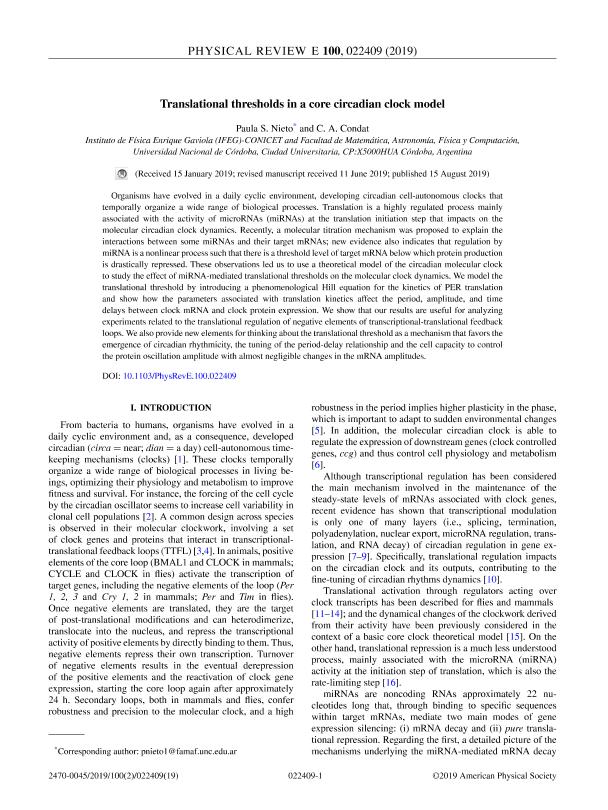Artículo
Translational thresholds in a core circadian clock model
Fecha de publicación:
08/2019
Editorial:
American Physical Society
Revista:
Physical Review E: covering statistical, nonlinear, biological, and soft matter physics
ISSN:
2470-0045
e-ISSN:
2470-0053
Idioma:
Inglés
Tipo de recurso:
Artículo publicado
Clasificación temática:
Resumen
Organisms have evolved in a daily cyclic environment, developing circadian cell-autonomous clocks that temporally organize a wide range of biological processes. Translation is a highly regulated process mainly associated with the activity of microRNAs (miRNAs) at the translation initiation step that impacts on the molecular circadian clock dynamics. Recently, a molecular titration mechanism was proposed to explain the interactions between some miRNAs and their target mRNAs; new evidence also indicates that regulation by miRNA is a nonlinear process such that there is a threshold level of target mRNA below which protein production is drastically repressed. These observations led us to use a theoretical model of the circadian molecular clock to study the effect of miRNA-mediated translational thresholds on the molecular clock dynamics. We model the translational threshold by introducing a phenomenological Hill equation for the kinetics of PER translation and show how the parameters associated with translation kinetics affect the period, amplitude, and time delays between clock mRNA and clock protein expression. We show that our results are useful for analyzing experiments related to the translational regulation of negative elements of transcriptional-translational feedback loops. We also provide new elements for thinking about the translational threshold as a mechanism that favors the emergence of circadian rhythmicity, the tuning of the period-delay relationship and the cell capacity to control the protein oscillation amplitude with almost negligible changes in the mRNA amplitudes.
Archivos asociados
Licencia
Identificadores
Colecciones
Articulos(IFEG)
Articulos de INST.DE FISICA ENRIQUE GAVIOLA
Articulos de INST.DE FISICA ENRIQUE GAVIOLA
Citación
Nieto, Paula Sofia; Condat, Carlos; Translational thresholds in a core circadian clock model; American Physical Society; Physical Review E: covering statistical, nonlinear, biological, and soft matter physics; 100; 2; 8-2019; 1-19; 022409
Compartir
Altmétricas




